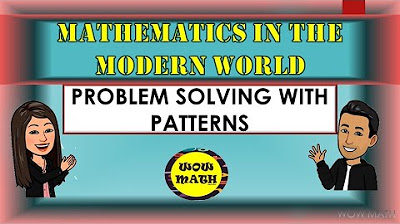Een formule voor een rij getallen zoeken
Summary
TLDRThis video explains how to derive mathematical formulas for sequences of numbers by identifying patterns. Using two examples, the presenter shows how to calculate the formula based on differences between consecutive terms. The first example works with a sequence (2, 5, 8, 11) and demonstrates the steps to find a formula involving multiplication by -3 and adding a constant (+1). The second example follows a similar approach but uses a different sequence (3, 2, 9). By the end, viewers will understand how to formulate predictions for any term in a given sequence.
Takeaways
- 😀 The script explains how to find a formula for a sequence of numbers.
- 😀 It starts with an example sequence of numbers: 2, 5, 8, 11.
- 😀 The goal is to determine a formula that allows predicting or calculating the 37th number in the sequence.
- 😀 The numbers are labeled using the letter 'n', and the values in the sequence are labeled with 'g'.
- 😀 The process starts by identifying the difference between consecutive numbers in the sequence.
- 😀 The difference between the first and second numbers is -2, the second and third is -3, and the third and fourth is -3.
- 😀 This pattern suggests that the formula will involve multiplying by -3.
- 😀 After multiplication, the formula needs an additional adjustment, which is adding 1.
- 😀 The formula derived from the example is: g = -3n + 1.
- 😀 A second example with a new set of numbers is introduced (3, 2, 9).
- 😀 In the second example, the formula involves multiplying the number by 2 and adding 1, resulting in g = 2n + 1.
Q & A
What is the primary objective of the video?
-The primary objective of the video is to explain how to find a formula for a number sequence, specifically by identifying patterns in arithmetic sequences.
How do we identify the formula for a number sequence?
-We identify the formula by looking for the common difference between consecutive numbers in the sequence, then use this difference to construct a general formula that can predict any term in the sequence.
What type of sequence is discussed in the first example?
-The first example discusses an arithmetic sequence where the difference between consecutive numbers is constant. In this case, the difference is +3.
What formula is derived from the first example?
-The formula derived from the first example is G = -3n + 1, where 'n' represents the position of the term in the sequence.
How do we derive the formula for an arithmetic sequence?
-To derive the formula for an arithmetic sequence, we multiply the position 'n' by the common difference and adjust with a constant based on the first term of the sequence.
What is the common difference in the second example?
-In the second example, the common difference between consecutive numbers is +2.
What is the formula derived from the second example?
-The formula derived from the second example is G = 2n + 1, where 'n' represents the position of the term in the sequence.
Why is it important to identify the common difference in a sequence?
-Identifying the common difference is crucial because it helps us determine the type of sequence (arithmetic) and guides the creation of the general formula that predicts any term in the sequence.
What role does the constant play in the formula?
-The constant in the formula adjusts the sequence so that the first term matches the actual value of the sequence when n = 1. It ensures that the formula is accurate for all terms.
How can this method be applied to other number sequences?
-This method can be applied to any arithmetic sequence by identifying the common difference, expressing the sequence in terms of 'n', and then constructing the general formula for predicting future terms.
Outlines

此内容仅限付费用户访问。 请升级后访问。
立即升级Mindmap

此内容仅限付费用户访问。 请升级后访问。
立即升级Keywords

此内容仅限付费用户访问。 请升级后访问。
立即升级Highlights

此内容仅限付费用户访问。 请升级后访问。
立即升级Transcripts

此内容仅限付费用户访问。 请升级后访问。
立即升级浏览更多相关视频

GENERATING PATTERNS IN SEQUENCES II GRADE 10 MATHEMATICS Q1

PROBLEM SOLVING WITH PATTERNS || MATHEMATICS IN THE MODERN WORLD

Pola Bilangan - Part 1

Barisan dan Deret Bagian 1 - Barisan Aritmetika Matematika Wajib Kelas 11

Arithmetic Sequences and Arithmetic Series - Basic Introduction

Number Sequence and Patterns|| Exercise 2.1 complete || class 8th Math || #newsyllabus2022_23
5.0 / 5 (0 votes)
